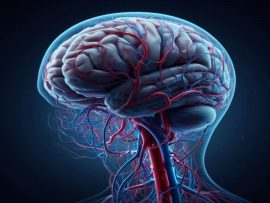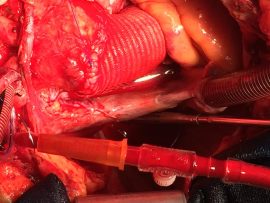Abstract Veno-arterial extracorporeal membrane oxygenation (ECMO) brings many monitoring pitfalls due to the countercurrent blood flow, which may create left ventricular overload and perfusion imbalances between the two cerebral hemispheres...
Read MoreAbstract The common carotid artery (CCA) is an easily accessible means of providing cerebral and systemic perfusion during complex aortic surgery. Our technique for using CCA perfusion through a graft..
Read MoreAbstract Background Selective antegrade cerebral perfusion, via unilateral antegrade cerebral perfusion (uACP) or bilateral antegrade cerebral perfusion (bACP) approaches, is used in aortic arch surgery to protect the brain during..
Read MoreAbstract OBJECTIVES The optimal flow rate for selective antegrade cerebral perfusion during aortic arch surgery is unknown. While 10–15 ml/kg/min is generally recommended, our centre has adopted a line pressure-targeted, relatively..
Read MoreAbstract The use of intra-aortic balloon pump (IABP) alongside venoarterial extracorporeal membrane oxygenation (VA-ECMO) in critically ill patients presenting refractory cardiogenic shock raises questions regarding its impact on organs perfusion...
Read MoreAbstract Objective The clinical importance of individualized blood pressure management in optimizing cerebral perfusion during cardiac surgery has been well established. However, consensus on blood pressure goals is lacking. The..
Read MoreAbstract Background and Objective: Effective cerebral perfusion monitoring is essential in aortic arch surgery, particularly when employing the Kazui technique under moderate hypothermia. Near-infrared spectroscopy (NIRS) provides real-time regional oxygen..
Read MoreAbstract OBJECTIVES To assess the effects of unilateral versus bilateral antegrade cerebral perfusion (u-ACP vs. b-ACP) on postoperative complications and mid-term follow-up results in Asian patients with acute type A..
Read MoreAbstract Background Systemic hypothermia with bilateral antegrade selective cerebral perfusion (ASCP) is the preferred cerebral protective strategy for type A aortic dissection surgery. The optimal ASCP flow rate remains uncertain..
Read MoreAbstract Background: Decreased cerebral oximetry (rSO2) in cardiac surgery is associated with postoperative delirium (POD). However, interventions optimizing intraoperative rSO2 are inconclusive. Methods: In this prospective observational cohort study, the..
Read MoreAbstract Introduction A well-known complication of veno-arterial extracorporeal membrane oxygenation (VA ECMO) is differential hypoxia, in which poorly-oxygenated blood ejected from the left ventricle mixes with and displaces well-oxygenated blood..
Read MoreAbstract Background Cerebral perfusion may change depending on arterial cannulation site and may affect the incidenceof neurologic adverse events in post‑cardiotomy extracorporeal life support (ECLS). The current study comparespatients’ neurologic..
Read MoreAbstract Background Impairment of cerebral autoregulation (CA) has been observed in patients undergoing cardiopulmonary bypass (CPB), but little is known about its risks and associations with outcomes. The cerebral oximetry..
Read MoreAbstract Objectives Acknowledging lacking of consensus exist in total aortic arch (TAA) surgery for acute type A aortic dissection (AAD), this study aimed to investigate the neurologic injury rate between..
Read MoreAbstract The risk of redo sternotomy is greatly elevated in the setting of aortic proximity to the sternum. Current strategies to avoid catastrophic neurologic injury upon sternal reentry include establishment..
Read MoreAbstract Aims The aim of this study was to document the postoperative outcomes of patients who underwent hypothermic circulatory arrest (HCA), the evolution of HCA management over time and to identify the..
Read MoreAbstract Background Direct cannulation of the innominate artery for selective antegrade cerebral perfusion has been shown to be safe in elective proximal aortic reconstructions. We sought to evaluate the safety..
Read MoreAbstract Cardiopulmonary bypass (CPB) is a standard technique for cardiac surgery, but comes with the risk of severe neurological complications (e.g. stroke) caused by embolisms and/or reduced cerebral perfusion. We..
Read MoreAbstract Background Aortic arch repair for aortic dissection is still associated with a high mortality rate. Providing adequate means of neuromonitoring to guide cerebral hemodynamics is advantageous, especially during selective anterior..
Read MoreAbstract Study objective Low (BIS) values have been associated with adverse postoperative outcomes. However, trials of optimizing BIS by titrating anesthetic administration have reported conflicting results. One potential explanation is that may..
Read MoreAbstract The use of total circulatory arrest (TCA)/deep hypothermic circulatory arrest (DHCA) as a support modality in congenital heart surgery is a time-tested strategy. However, with technological advances, the widespread..
Read MoreAbstract Aim Hypothermia and selective brain perfusion is used for brain protection during an acute type A aortic dissection (ATAAD) correction. We compared the outcomes between antegrade and retrograde cerebral..
Read More















